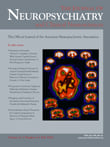Mr. A, a 47-year-old white man, was diagnosed with major depressive disorder for about 12 years. He had no prior episodes of hypomania or mania and no family history of bipolar disorder. About a year and a half ago, he had a coronary artery bypass surgery and the postsurgical period was complicated by respiratory and renal failure and an ischemic stroke. The patient had a protracted recovery from the above events over a month. A head CT scan at that time showed an infarct in the left inferior frontal region. At that time, the patient was being treated with sertraline, 200 mg/day, and this was continued after his discharge from the hospital. Mr. A was subsequently switched to bupropion, sustained-release 300 mg/day in divided doses, and was taking this medication until his index admission to the psychiatric unit. A year after the stroke, the patient’s family noticed that he was having memory problems and would get confused about where he was. He would also get lost in his own home, would leave the stove burner on, and had difficulty finding words. About 5 months after the onset of the cognitive decline, and for a couple of weeks before admission, Mr. A was noted to be getting increasingly irritable. He displayed extreme mood swings wherein he would cry spontaneously or would be very angry. In addition to the mood lability, he was hyperactive and talkative, displayed flight of ideas, had decreased need for sleep, and had inflated self-esteem with grandiose plans to expand his business. He also developed psychotic symptoms and believed that his wife was cheating on him. His wife reported an episode where the patient was seeing objects on the wall. His admission to the psychiatric unit was precipitated after he threatened to hurt his family members.
During his admission, Mr. A had an extensive work-up done. His blood counts were normal. BUN was normal while serum creatinine was 1.38 mg/dl (normal range=0.70–1.20 mg/dl), which was at baseline because of prior history of renal insufficiency. His fasting blood glucose was elevated at 127 mg/dl (normal range=65–100 mg/dl), and he had been diagnosed with type 2 diabetes mellitus, which was being treated by diet. His liver function tests, TSH, B
12 and folate levels were normal, and rapid plasma reagin was nonreactive. Urine drug screen was positive for benzodiazepine and opioids as the patient was prescribed temazepam and propoxyphene/acetaminophen, but the patient did not have any history of illicit drug or alcohol use. He scored 18/30 on the Montreal Cognitive Assessment,
5 with deficits in the domains of visuospatial/executive functions, attention, verbal fluency, abstraction, and delayed recall. His orientation was intact. He scored 15/18 on the Frontal Assessment Battery
6 and had deficits in conceptualization and lexical fluency. Mr. A’s brain MRI showed several foci of hyperintensities in the white matter and basal ganglia on T2-weighted images. An area of encephalomalacia 1 cm in diameter was seen in the region corresponding to the infarct seen on the previous head CT scan. The patient was diagnosed with vascular mania according to recently proposed criteria,
1 along with vascular dementia (per DSM-IV-TR), and bupropion was discontinued. Ziprasidone and carbamazepine extended-release were started and increased to 80 mg b.i.d. with meals and 800 mg b.i.d., respectively. Donepezil was also started at 5 mg/day for symptoms of dementia. Over the next 2 weeks, the patient significantly improved in his presentation, and prior to discharge he did not display any overt manic or psychotic symptoms, although his cognitive deficits continued. Of note, the patient also showed a marked decrease in spontaneous crying spells.

